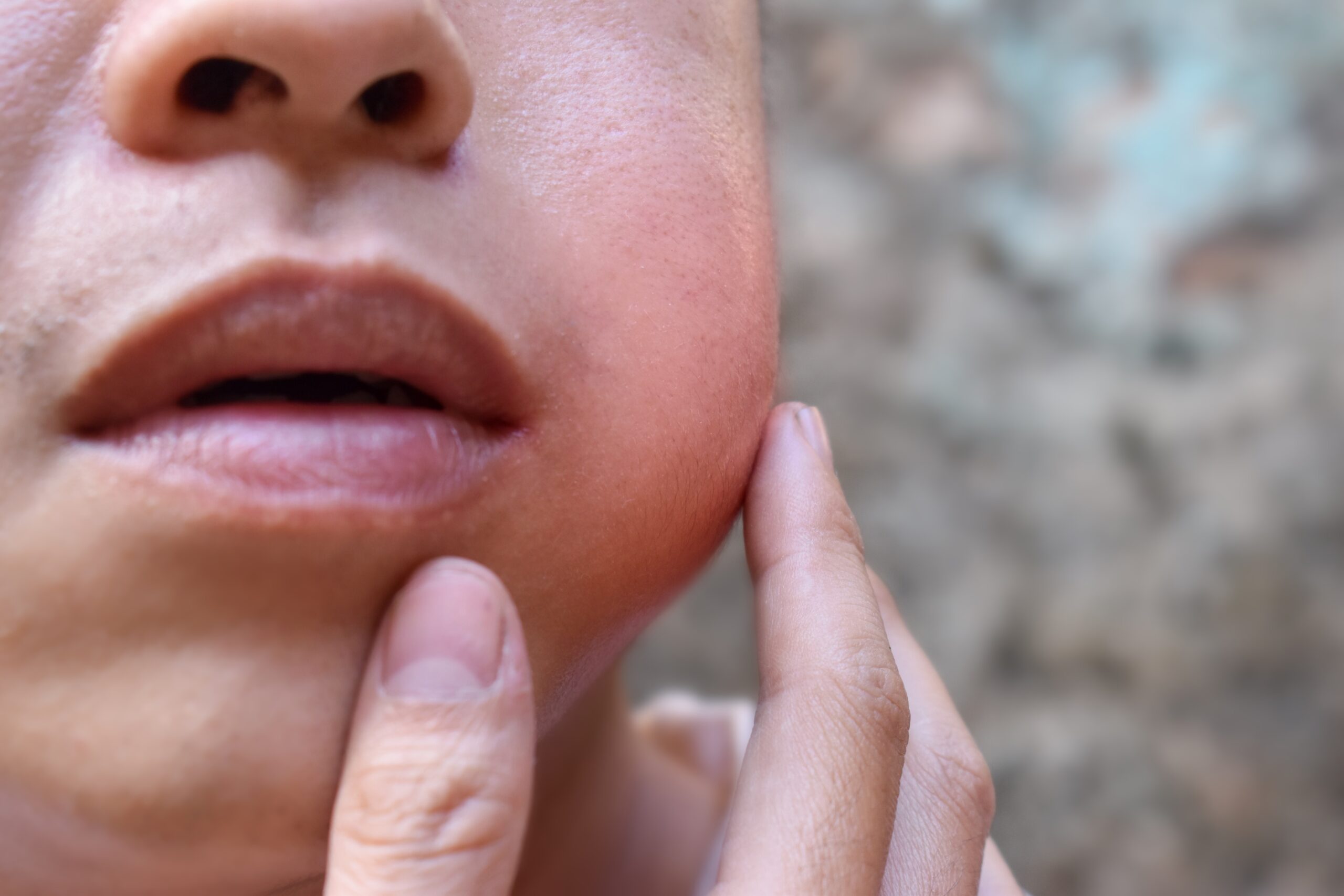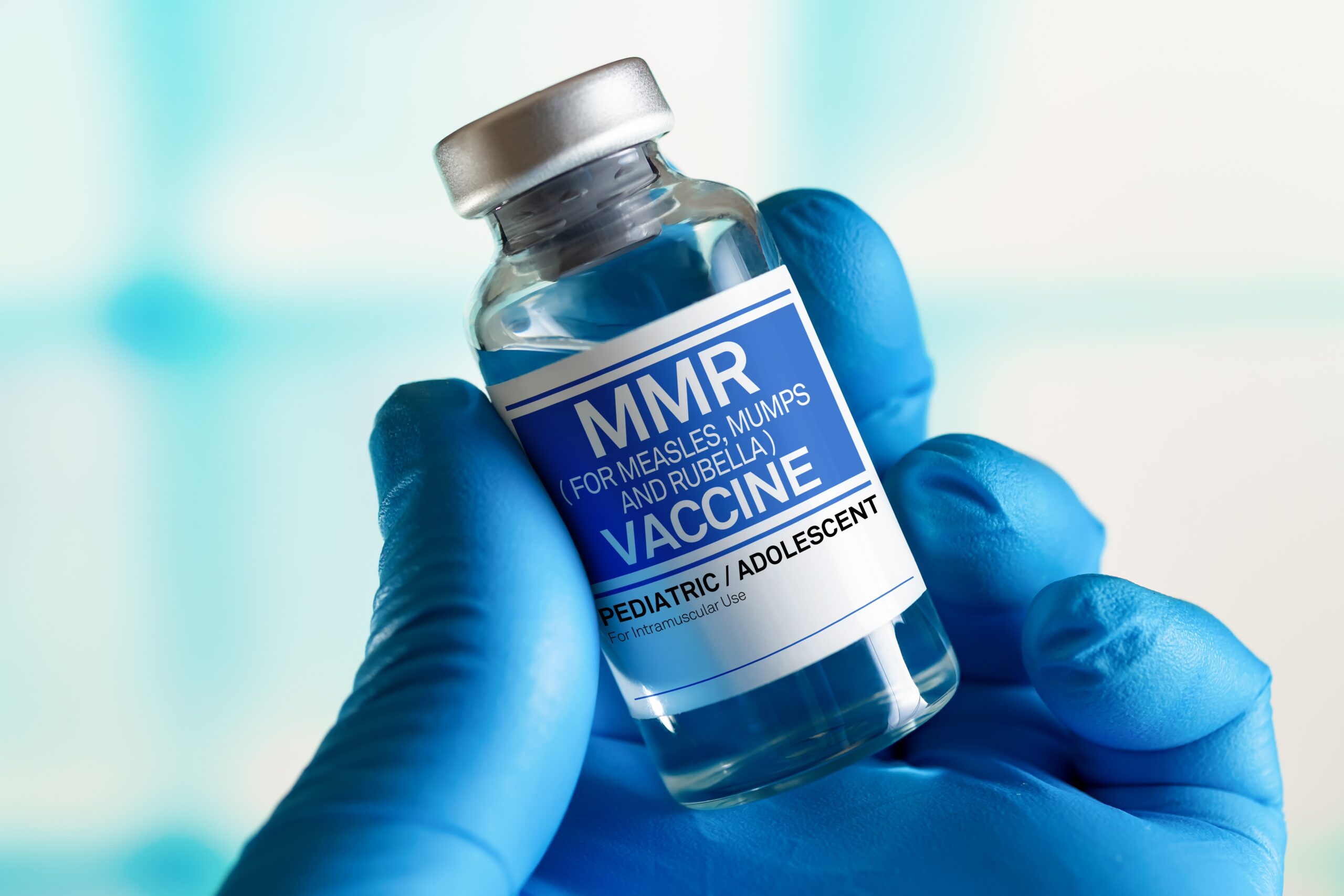Mumps is a viral infectious disease that mainly occurs in children but can sometimes affect adults. It is usually mild, but some symptoms should be watched because they may indicate dangerous complications.
Typically, the disease starts with nonspecific symptoms, such as fever, fatigue, and muscle aches, followed by swelling of the major salivary glands (parotitis). Parotitis patients complain about pain around salivary glands, swollen jaw, and dry mouth.
The disease is most often self-limiting, and people fully recover. However, dangerous complications may occur, including arthritis, deafness, and meningitis. The MMR vaccine (measles, mumps, and rubella) can effectively prevent the disease and its complications.

The mumps virus, a single-stranded RNA paramyxovirus![]() , causes the disease. The virus is spread from one person to another, and humans are the only source of it. Due to the virus’s specific structure, it doesn’t change its structure much. Thanks to that, vaccinations typically produce long-lasting immunity.
, causes the disease. The virus is spread from one person to another, and humans are the only source of it. Due to the virus’s specific structure, it doesn’t change its structure much. Thanks to that, vaccinations typically produce long-lasting immunity.
The virus spreads through contact with saliva or infected droplets from an infected person’s throat, mouth, and nose. Therefore, the infection can be transmitted through:
Mumps mainly affects young children between 2 and 10 years old. Most cases are among children who have not been vaccinated against the disease. However, being vaccinated doesn’t guarantee you won’t ever get sick. With time, the number of antibodies required after vaccination decreases, and you become more susceptible to infection. Even when a vaccinated person becomes ill, the symptoms are less severe, and complications occur less often.
Adults and adolescents get sick less often than children. The course of the disease is typically more severe in adults, and complications are more common in that group. Mumps cases are observed all year round.
Some people are at a higher risk of getting mumps. Risk groups include:
Adults are less likely to acquire the virus but are at higher risk of more severe course and complications than children.
Mumps is a disease that occurs only in humans. The virus is transmitted through an infected person. The infection spreads through inhaling droplets, contact with saliva, and respiratory discharge dispersed by ill patients when coughing and sneezing. Some sick people might be asymptomatic or have few symptoms but can still spread the virus to others.
Mumps is contagious. After contact with the virus, most susceptible people become ill. Large disease outbreaks occur, for example, in college dormitories or the army. An infected person is contagious for 1-2 days before the onset of salivary gland swelling and stops being able to infect another person up to five days after swelling onset.
The incubation period is the- that days from when the virus gets into the body to when the first signs of the sickness show up, is 12-25 days.
Since 1967, children in the United States have received two doses of the MMR vaccine (for measles, mumps, and rubella), and mumps cases have dropped significantly. Before that, most children have been getting the disease during childhood. MMR vaccines led to a decrease of 99% in disease cases; within 35 years, the incidence dropped from 150,000 to around 200 a year.
However, since 2006, cases have been increased mainly among young adults. Large outbreaks are occasionally observed among large groups of people, such as college campuses.
After contact with the virus, it enters the body. The incubation period is the time between the virus’s entry and the beginning of the symptoms, is 12-25 days. Disease symptoms start with mild signs, including:
After the initial period of the disease, the salivary glands start to swell painfully. There are three types of salivary glands: the parotid gland, the submandibular gland, and the sublingual gland.
Swelling of the salivary glands is the most characteristic symptom of mumps. Typically, only the parotid salivary gland swells (parotitis), but other salivary glands may also swell in some people. Parotid glands are glands located symmetrically on both sides of the face, near the ears. The parotid gland is the biggest saliva-making gland, and it weighs about 30 grams. The carotid artery runs through the parotid gland, with lymph nodes and vessels inside. It primarily produces saliva, which flows down the duct into the oral cavity and is responsible for producing 50%![]() of saliva.
of saliva.
The salivary glands can swell on one or both sides of the face. Parotitis occurs in around 70% of the disease cases. Gland inflammation usually passes within a week.
Among males, testes inflammation occurs as the second most common disease symptom. Testicular inflammation includes painful, swollen, enlarged testicles with tenderness. Testes inflammation most often occurs on one side of the body, less commonly bilaterally.
Rarely the disease can cause neurological symptoms such as meningitis, brain inflammation, or hydrocephalus. Therefore, call for an emergency consult with your child’s physician if you notice the following symptoms:
Some people don’t have any symptoms but can still be the source of the virus and spread it to others.
There is no evidence that mumps during pregnancy lead to fetal malformations or premature birth. However, like any viral infection, it can cause problems in the early stages of pregnancy.

Adults rarely suffer from mumps, as they most often suffer from the disease as children, which provides them with lasting immunity and protects them against the disease in adulthood. However, if someone avoids contact with the disease in childhood and is not vaccinated, they can get mumps regardless of age.
While the disease is often mild in children, adolescents and adults may experience more severe symptoms. They may require hospitalization more often due to complications of the disease, such as inflammation of the testicles, meningitis, and pancreatitis.
Mumps symptoms in adults are the same as in children, but the course of the disease may be more severe, and complications are more common. Symptoms usually appear between 12 and 25 days after exposure to the mumps virus. Many infected people do not have any symptoms, and some have flu-like symptoms without involvement of the salivary glands.
Prodromal symptoms of mumps are also non-specific and include muscle pain, loss of appetite, malaise, headaches, and low-grade fever. Symptoms of the developed disease include swelling of one or more salivary glands, most often located at the jaw. The affected salivary glands are painful and tender during the first days of the disease.
Parotid gland swelling with simultaneous swelling and redness of the salivary duct openings in the mouth is characteristic enough that it usually allows for a quick diagnosis of mumps based on a clinical examination.
Details of the medical history may help confirm the diagnosis. Your or your child’s physician may ask you the following questions:
The lack of the disease during childhood and not being vaccinated makes a diagnosis more likely.
If there are doubts, laboratory tests confirm the infection and possible complications. An RT-PCR test can detect the virus in saliva by swabbing the cheek. This test should be done up to three days after the salivary gland swelling onset. Another test confirming the disease is the blood test, which detects the rise of IgM and IgG immunoglobulins.
Additional tests are necessary for people who require hospitalization. For example, blood tests for pancreas enzymes and ultrasound are helpful when doctors suspect pancreatitis. If your child has neurological complications, your doctor may order a cerebrospinal fluid (CSF) test to confirm meningitis or brain inflammation.
Mumps passes on its own, and there is no specific treatment. Typically, the disease passes within one week of the swelling beginning. Treatment is based on alleviating the symptoms and ensuring the child stays hydrated. The steps you can take include:
In most cases, mumps has a mild course and passes independently. However, complications may occur in some people. The most common ones include swollen testicles, pancreatitis, meningitis, brain inflammation, and swollen ovaries. Rare complications include deafness and arthritis.
Swollen and painful testicles occur in 1 in 3 males![]() with mumps who get sick after puberty. This condition is sometimes called orchitis. Swelling of the testicle typically occurs suddenly, with pain and tenderness of the area. This complication usually concerns one side of the body.
with mumps who get sick after puberty. This condition is sometimes called orchitis. Swelling of the testicle typically occurs suddenly, with pain and tenderness of the area. This complication usually concerns one side of the body.
The swelling usually occurs 4-8 days after salivary gland swelling onset. Rarely, it can happen up to 6 weeks from the gland enlargement.
This condition usually passes without any treatment. The pain can be eased using painkillers, such as paracetamol or ibuprofen, and cold or heat compresses. If the pain is too intense and those substances don’t help it, contact your physician. It is important to wear supportive underwear during testicle inflammation as it alleviates the discomfort.
Up to 40%![]() of men who experience testicle swelling during mumps notice some shrinkage of its size. Some men, after mumps-related testicle inflammation, develop a drop in sperm count. However, it usually doesn’t cause infertility.
of men who experience testicle swelling during mumps notice some shrinkage of its size. Some men, after mumps-related testicle inflammation, develop a drop in sperm count. However, it usually doesn’t cause infertility.
1 in 25 people![]() sick with mumps develop pancreas inflammation (pancreatitis). It is an acute (short-term) pancreatitis that is usually mild, but still, you may get admitted to the hospital to help you recover. The symptoms of pancreatitis include:
sick with mumps develop pancreas inflammation (pancreatitis). It is an acute (short-term) pancreatitis that is usually mild, but still, you may get admitted to the hospital to help you recover. The symptoms of pancreatitis include:
Every 1 in 4 people with mumps gets this complication. It occurs when the virus spreads to the meninges, the protective outer layer of the brain. The symptoms of viral meningitis include:
Viral meningitis is usually mild and not life-threatening. The symptoms typically pass within two weeks![]() .
.
1 in 15 women![]() with mumps experience ovaries swelling as a complication. The symptoms include fever, abdominal pain, nausea, and vomiting. It usually passes when the symptoms of mumps disappear and doesn’t have long-lasting consequences.
with mumps experience ovaries swelling as a complication. The symptoms include fever, abdominal pain, nausea, and vomiting. It usually passes when the symptoms of mumps disappear and doesn’t have long-lasting consequences.

The MMR vaccine is a drug that provides immunity against the measles, mumps, and rubella viruses. It contains viruses that cannot cause disease but allow the body to produce antibodies. The MMR vaccine is very effective – two doses provide lasting immunity in most people. The first dose of the vaccine is administered between 12 and 15 months of age, and the second dose is when a child is between 4-6 years old.
Vaccines are designed to ensure maximum effectiveness with the highest level of safety. It may cause side effects in some people. The most common complications of the MMR vaccine![]() include:
include:
Vaccines must not be administered to children with severely compromised immune systems. Tell your doctor if your child has a suspected or diagnosed immune deficiency or is taking medications that weaken the immune system (e.g., chemotherapy, steroid anti-inflammatory drugs, post-transplant drugs).
If you notice symptoms of mumps in your child or yourself, especially swelling in the salivary glands or inflammation of the testes, you should contact your physician.
If any neurological symptoms occur in the child or you, call for emergency medical help. Those include severe headache, high fever, neck stiffness, vomiting, confusion, and seizures.